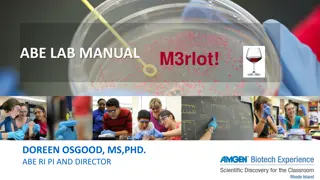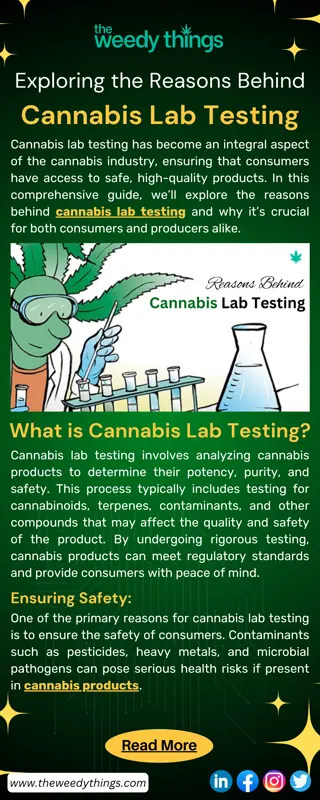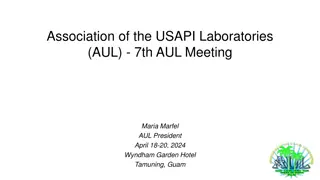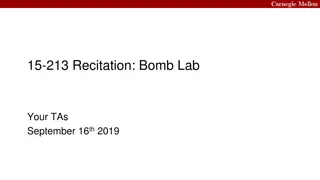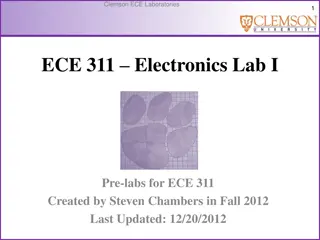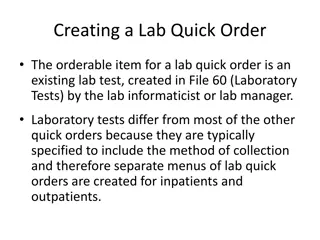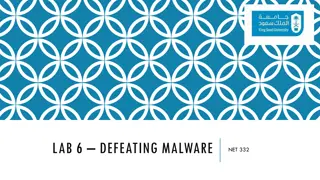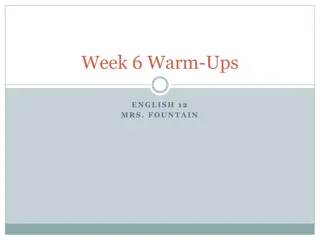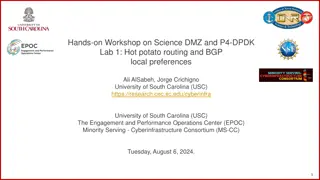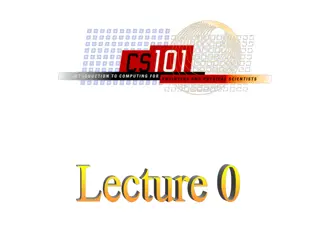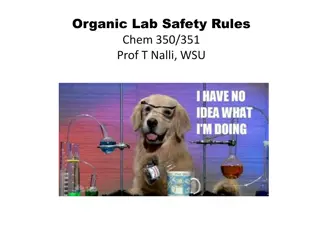
Gravimetric Analysis of Mixtures
Explore the detailed setup and procedure for conducting gravimetric analysis of mixtures in a laboratory setting. Learn about the equipment needed, chemicals involved, and step-by-step instructions for accurate analysis. Ensure proper labeling, care, and disposal techniques are followed for a successful experiment.
Download Presentation

Please find below an Image/Link to download the presentation.
The content on the website is provided AS IS for your information and personal use only. It may not be sold, licensed, or shared on other websites without obtaining consent from the author. If you encounter any issues during the download, it is possible that the publisher has removed the file from their server.
You are allowed to download the files provided on this website for personal or commercial use, subject to the condition that they are used lawfully. All files are the property of their respective owners.
The content on the website is provided AS IS for your information and personal use only. It may not be sold, licensed, or shared on other websites without obtaining consent from the author.
E N D
Presentation Transcript
Things for AP Lab Set Ups
Unit 0 Unit 0 Honors Chem Chem Review Review Honors
Gravimetric Analysis Gravimetric Analysis of a Mixture of a Mixture
Gravimetric Analysis of a Mixture Equipment in Yellow Bins Beaker, 250 mL Filter flask with Buchner Funnel Graduated cylinder, 100 mL Glass stir rod Rubber policeman Filter paper, qualitative Weigh boat Digital scale Drying oven Wash Bottle with DI H2O Large beaker up front on demo table Larger white tray up front on demo table Chemicals Mixture of NaCl and Na2CO3in a vial (~2 g of mixture) 0.40 M CaCl2solution, 80mL CaCl2 solution in beaker(s) up front with pipettes. They will get 80mL up front and bring back to table.
1 trial Sample % Amount in each vial # benches x _____ periods = total needed 4 grams x 0.35 Na2CO3 x 0.65 NaCl 1.40 g Na2CO3 2.60 g NaCl x 8 x 4.25 = 47.6 g x 8 x 4.25 = 88.4 g 0.40 M CaCl2 Needed 80 mL # benches Per period x ____ periods = total needed Rounded up for extra x 8 = 640 mL x 4 = 2560 mL Make ___3____ Liters 8 vials per period x ___ periods 4 To make 1 L CaCl2 = 44.392 g CaCl2 Total # vials 32 1 L 0.40 mol 110.98 g + a few extra = 35 1 L 1 mol CaCl2 Teacher s Notes: Fill a 5mL screw top vial ~4mL full. Err on the side of a little more. Trying to get roughly 4g in each tube. All benches get their own vial per period. Making CaCl2 exothermic. Gets decently hot. Mix slowly in beaker then transfer to vol. flask and dilute to mark. Teacher s Notes: a 35% Na2CO3 to 65% NaCl mixture works well for this procedure. If you up the percentage of Na2CO3, then increase the CaCl2 solution to ensure that all the CO32- is precipitated out.
Gravimetric Analysis of a Mixture DON T FORGET LABEL WEIGH BOAT WITH LAB BENCH AND PERIOD! Dry weight of weigh boat + filter paper Wet filter paper down! Filter carefully keep that ppt on top of the filter paper! Cleanup Goggles in UV Cabinet nicely! Reset trays for next period! Filtrates can go down the drain FLUSH DRAIN WITH WATER! Precipitate + filter paper in weigh boat UP FRONT IN BIN! Plastic vial with orange lid UP FRONT IN BIG BEAKER!
Gravimetric Analysis of a Mixture Last period of the day DON T FORGET LABEL WEIGH BOAT WITH LAB BENCH AND PERIOD! Dry weight of weigh boat + filter paper Wet filter paper down! Filter carefully keep that ppt on top of the filter paper! Clean up instructions will be on next slide towards the end of the class period!
Cleanup Goggles in UV Cabinet nicely! Filtrates and extra CaCl2 can go down the drain FLUSH DRAIN WITH WATER! Precipitate + filter paper in weigh boat UP FRONT IN BIN! Plastic vial with orange lid UP FRONT IN BIG BEAKER! Hand pump up front in pink bin! Stir rod drawer table 2 Buchner Funnels bin up front Trays - stacked nicely by table 5 Put away in cabinets/drawers: Any clean/dry beakers in top cabinets, shelves have labels for sizes you can leave tape on them Grad Cylinders top cabinet by table 3 DI water bottles top cabinet by table 3 Filter Flasks top cabinet by table 4-5 Throw away: Pipettes Paper towels Stay on table: Nothing!
Gravimetric Analysis of a Mixture DAY 2 DON T FORGET USE THE SAME SCALE YOU USED YESTERDAY! Cleanup Dry precipitate and filter paper in trash after Day 2 Report data on shared spreadsheet https://tinyurl.com/2p894e48
% Comp Ag % Comp Ag- -Cu Alloy Bead Alloy Bead Cu
% Comp Ag % Comp Ag- -Cu Alloy Bead Cu Alloy Bead 25mL graduated cylinder NaCl up front Scale up front 70% alcohol up front Plastic grad cylinder up front Day 3 Scale DAY 2 100 mL beaker DI water Weigh Boat Labeled Scoop Stir rod Buchner funnel w/ collar Filter flask Hose/aspirator/beaker in sink Filter paper + mesh disk Hot plate DAY 1 100 mL beaker labeled Watch Glass Weigh Boat labeled 6 M Nitric Acid in hood Graduated Cylinder in hood
DAY 1 DAY 1 Put weigh boat on scale Tare the scale Weigh the bead Put bead in beaker Bring to hood Add 10mL nitric acid Watch Glass Sit in hood over night Calculate NaCl needed to ppt 100% Ag bead
DAY 2 DAY 2 Weigh weighboat + dry filter paper Set up Buchner funnel Weigh 2x NaCl calculated on Day 1 into beaker up front Add 25 mL H2O to make salt solution Add NaCl sol n to dissolved bead Filter Rinse with nitric acid wash share the bottle Rinse with 10mL alcohol up front Collect on weigh boat Dry overnight
DAY 3 DAY 3 Weigh weighboat + filter paper + product Do calculations
Bead = 92% Ag Bead = 92% Ag
Unit 1 Unit 1 Thermochemistry Thermochemistry
Determining the Enthalpy Determining the Enthalpy of a Reaction w/microscale of a Reaction w/microscale calorimetry calorimetry
Enthalpy of a Rxn 2 trials Equipment Vernier computer interface Temp probe Microcalorimeter Forceps Weigh boat 25mL grad cylinder Stir plate Scoopula Stir bar and pink labeled stir bar beaker DI H2O bottle Chemicals 1.0 M HCl x 500mL per period MgO x 2g per period Mg ribbon x 60cm per period Shared Lab Data: https://tinyurl.com/2p894e48
TWO TRIALS Teacher s Notes: Accepted Value = MgO Heat of formation = -601.6 kJ/mol Chemical per period x _____ periods = total needed Rounded up for extra HCl, 1.0 M 480 mL x 4 1920 mL 3 L MgO 1.6 g x 4 6.4 g 10 g Mg ribbon 56 cm x 4 224 cm 250 cm M1V1 = M2V2 V1 = M2V2 M1 M2 V2 1 1 L M1V1 = M2V2 V1 = M2V2 M1 M2 V2 1 1 L To make 1 L HCl To make 1 L HCl M1 6 M V1 = 0.333 L = 167 mL M1 3 M V1 = 0.333 L = 333 mL
Tips One graph with two trial lines Write down which color line is which trial Cleanup Goggles in UV Cabinet nicely! Reset trays for next period! Used chemicals can go down the drain FLUSH DRAIN WITH WATER! MgO Beakers UP FRONT! WIPE DOWN BENCHES WITH WATER and TOWELS Report data on shared spreadsheet https://tinyurl.com/2p894e48
Cleanup Goggles in UV Cabinet nicely! Put away in cabinets/drawers: Graduated cylinders top cabinet by table 3 DI water bottles top cabinet by table 3 Forceps in drawer on table 3 Scoopula in drawer under DI water jug near table 2 Trays - stacked nicely by table 5 Stay on table: Nothing! Table 8 Stir plate and cord Stir bar inside pink beaker Stir bar retriever Vernier computer interface back in the box NICELY Temp probe dry and in plastic bag NICELY Calorimeter DRIED Weigh boats DRIED Trash Paper towels WIPE DOWN BENCHES WITH WATER and TOWELS
Determining the Determining the Enthalpy of a Enthalpy of a Reaction Reaction
Equipment Vernier computer interface Temp probe Styrofoam cup 600mL beaker 2 x 250mL beaker (to come get chemicals) 50mL graduated cylinder Stir bar Stir plate Ring stand Utility clamp DI H2O bottle Enthalpy of a Enthalpy of a Rxn Rxn 3 trials 3 trials Chemicals 2.0 M HCl x 750mL per period 2.0 M NaOH x 750mL per period 2.0 M NH4Cl x 450mL per period 2.0 M NH4OH x 450mL per period Thermo data Shared Lab Data: https://tinyurl.com/2p894e48
Enthalpy of a Rxn 2 trials Equipment Vernier computer interface Temp probe Styrofoam cup 600mL beaker 2 x 250mL beaker (to come get chemicals) 50mL graduated cylinder Stir bar Stir plate Ring stand Utility clamp DI H2O bottle Chemicals 2.0 M HCl x 500mL per period 2.0 M NaOH x 500mL per period 2.0 M NH4Cl x 300mL per period 2.0 M NH4OH x 300mL per period Thermo data Shared Lab Data: https://tinyurl.com/2p894e48
THREE TRIALS Teacher s Notes: Make the NaOH in a beaker with 700mL water, let cool, transfer to volumetric and dilute. Stir again. Chemical mL per period x _____ periods = total needed Rounded up for extra HCl, 2.0 M 750 x 4 3000 mL 4 L NaOH, 2.0 M 750 x 4 3000 mL 4 L NH4Cl, 2.0 M NH4OH, 2.0 M 450 x 4 1800 mL 3 L 450 x 4 1800 mL 3 L M1V1 = M2V2 V1 = M2V2 M1 M2 V2 2 1 L To make 1 L NaOH To make 1 L NaOH 1 L 2.0 mol 40 g = 80 g NaOH or M1 4 M V1 = 0.5 mL = 500 mL 1 L 1 mol NaOH To make 1 L NH4Cl = 106.98 g NH4Cl 1 L 2.0 mol 53.49 g 1 L 1 mol NH4Cl M1V1 = M2V2 V1 = M2V2 M1 M2 V2 2 1 L M1V1 = M2V2 V1 = M2V2 M1 M2 V2 2 1 L To make 1 L NH4OH To make 1 L HCl M1 V1 = 0.1351 mL = 135.1 mL M1 12 M V1 = 0.1667 mL = 166.7 mL 14.8 M
TWO TRIALS Teacher s Notes: Make the NaOH in a beaker with 700mL water, let cool, transfer to volumetric and dilute. Stir again. Chemical mL per period x _____ periods = total needed Rounded up for extra HCl, 2.0 M 500 x 4 2000 mL 3 L NaOH, 2.0 M 500 x 4 2000 mL 3 L NH4Cl, 2.0 M NH4OH, 2.0 M 300 x 4 1200 mL 2 L 300 x 4 1200 mL 2 L M1V1 = M2V2 V1 = M2V2 M1 M2 V2 2 1 L To make 1 L NaOH To make 1 L NaOH 1 L 2.0 mol 40 g = 80 g NaOH or M1 6 M V1 = 0.333 L = 333 mL 1 L 1 mol NaOH To make 1 L NH4Cl = 106.98 g NH4Cl 1 L 2.0 mol 53.49 g 1 L 1 mol NH4Cl M1V1 = M2V2 V1 = M2V2 M1 M2 V2 2 1 L M1V1 = M2V2 V1 = M2V2 M1 M2 V2 2 1 L To make 1 L NH4OH To make 1 L HCl M1 6 M V1 = 0.3333 mL = 333.3 mL M1 6 M V1 = 0.333 L = 333 mL
Part 1 Lab bench #1 and #2 Rxn 1 = 13 deg 50mL HCl + 50mL NaOH Part 2 Lab bench #3, #4 and #5 Rxn 2 1 deg 50mL NH4Cl + 50mL NaOH Part 3 Lab bench #6, #7 and #8 Rxn 3 11 deg 50mL HCl + 50mL NH4OH Part 4 - Everyone Data analysis Find max/min temps Report data on shared spreadsheet
Tips One graph with two trial lines After each trial Experiment Store latest run Write down which color line is which trial Rxn 1 Lab bench #1 and #2 50mL HCl + 50mL NaOH Rxn 2 Lab bench #3, #4 and #5 50mL NH4Cl + 50mL NaOH Cleanup Goggles in UV Cabinet nicely! Reset trays for next period! Used chemicals can go down the drain FLUSH DRAIN WITH WATER! Extra chemicals STAY ON THE TABLE! Rxn 3 Lab bench #6, #7 and #8 50mL HCl + 50mL NH4OH Part 4 - Everyone Data analysis Find max/min temps Report data on shared spreadsheet https://tinyurl.com/2p894e48
Cleanup Goggles in UV Cabinet nicely! Put away in cabinets/drawers: Graduated cylinders top cabinet by table 3 DI water bottles top cabinet by table 3 Any clean/dry beakers in top cabinets, shelves have labels for sizes you can leave tape on them Trays - stacked nicely by table 5 Stay on table: Ring stand w/clamp Stir Plate with cord unplugged, nicely next to the stir plate Up Front Stir bar Stir bar retriever Vernier computer interface back in the box Temp probe Styrofoam cup Trash Pipettes Paper towels WIPE DOWN BENCHES WITH WATER and TOWELS
Unit 2 Unit 2 Thermodynamics Thermodynamics
Determining the Determining the Entropy of a Entropy of a Reaction Reaction
Equipment Vernier computer interface Temp probe Styrofoam cup small w/a lid 600mL beaker 100mL beaker w/color tape 50mL graduated cylinder Stir bar and wand Scoop Weigh boat Stir plate Ring stand Utility clamp DI H2O bottle 4 goggles in each tray Entropy of a Entropy of a Rxn Rxn Chemicals NaNO3 x 8.5 g per table x 2 benches NH4Cl x 5.5 g per table x 3 benches NH4NO3x 8 g per table x 3 benches
TWO TRIALS Teacher s Notes: CHECK MASSES in the chemical bottles Accepted dS NH4NO3 = 108 J/mol.K Chemical g per trial x 2 trials x _____ tables x _____ periods = total needed NaNO3 NH4Cl NH4NO3 4.25 8.5 x 2 x 4 68 g 2.675 5.349 x 3 x 4 64.2 g 4 8 x 3 x 4 96 g NH4NO3 T = -5 To make 50mL 1 M NaNO3 (student s make at their bench) = 4.25 g NaNO3 0.05 L 1.0 mol 85.00 g 1 L 1 mol NaNO3 To make 50mL 1 M NH4Cl NaNO3 (student s make at their bench) = 2.675 g NH4Cl 0.05 L 1.0 mol 53.49 g 1 L 1 mol NH4Cl To make 50mL 1 M NH4NO3 NaNO3 (student s make at their bench) = 4 g NH4NO3 0.05 L 1.0 mol 80 g 1 L 1 mol NH4NO3
TWO TRIALS Teacher s Notes: CHECK MASSES in the chemical bottles Accepted dS NH4NO3 = 108 J/mol.K Chemical g per trial x 2 trials x _____ tables x _____ periods = total needed NaNO3 NH4Cl NH4NO3 4.25 8.5 x 2 x 4 68 g 2.675 5.349 x 3 x 4 64.2 g 1.2 2.4 x 8 x 4 77 g NH4NO3 T = -5 To make 50mL 1 M NaNO3 (student s make at their bench) = 4.25 g NaNO3 0.05 L 1.0 mol 85.00 g 1 L 1 mol NaNO3 To make 50mL 1 M NH4Cl NaNO3 (student s make at their bench) = 2.675 g NH4Cl 0.05 L 1.0 mol 53.49 g 1 L 1 mol NH4Cl To make 50mL 1 M NH4NO3 NaNO3 (student s make at their bench) = 1.2 g NH4NO3 0.015 L 1.0 mol 80 g 1 L 1 mol NH4NO3
Tips One graph with three trial lines After each trial Experiment Store latest run Write down which color line is which trial Chemicals NaNO3 = benches 1, 2 NH4Cl = benches 3, 4, 5 NH4NO3= benches 6, 7, 8 Cleanup Goggles in UV Cabinet nicely! Reset trays for next period! Stir bar to me! Used chemicals can go down the drain FLUSH DRAIN WITH WATER!
Tips One graph with two trial lines After each trial Experiment Store latest run Write down which color line is which trial Chemicals NH4NO3= ALL benches this year! Cleanup Goggles in UV Cabinet nicely! Reset trays for next period! Unused chemicals stay on table Used chemicals can go down the drain FLUSH DRAIN WITH WATER!
Chemicals NH4NO3= ALL benches this year! Cleanup Goggles in UV Cabinet nicely! Reset trays for next period! Unused chemicals stay on table Used chemicals can go down the drain FLUSH DRAIN WITH WATER!
Cleanup Goggles in UV Cabinet nicely! Put away in cabinets/drawers: Graduated cylinders top cabinet by table 3 DI water bottles top cabinet by table 3 Scoop drawer table 2 Any clean/dry beakers in top cabinets Stir Plate cords in the blue bin up front stir plate in top cabinets by table 5 Weigh boats washed, dried, in top cabinet by back door Trays - stacked nicely by table 5 Stay on table: Ring stand w/clamp Hot plate Cords UP FRONT! Any beakers with extra chemicals Up Front Vernier computer interface back in the box Temp probe clean and dry! Styrofoam cup clean and dry! Stir bars Hot plate cords Stir plate cords
Unit 3 Unit 3 Kinetics Kinetics
Beers Law Activity Beers Law Activity
Equipment Venier computer interface Spectrometer Cuvette 20x150 mm test tubes x5 50mL graduated cylinder 100mL beakers x2 Reusable Pipettes x 2 Pipette pumps Test tube rack Stir rod Kimwipes Distilled H2O bottle Beer s Law Activity Beer s Law Activity Chemicals 0.40 M copper (II) sulfate solution 250 mL per period Unknown concentration ~0.20 M Sometimes CuCl2 BLUE pipette = copper Green = unknown Unlabled = water
1 Trial Chemical mL per table x _____ tables x _____ periods = total needed Rounded up for extra 0.40M CuSO4 0.20 CuSO4 30 x 8 x 4 960 mL 2 L 5 x 8 x 4 160 mL 1 L To make 1L 0.40M CuSO4 H2O = 99.87 g CuSO4 Teacher s Notes: Accepted value = ~0.20 M 0.2 M done, need more copper sulfate to make 0.4 M 1 L 0.40 mol 249.68 g 1 L 1 mol CuSO4 H2O To make 1L 0.20M CuSO4 H2O = 49.94 g CuSO4 1 L 0.2 mol 249.68 g Slow to dissolve but will. Mix in a big beaker first until dissolved then pour in vol. flask and dilute to mark. 1 L 1 mol CuSO4 H2O Optimal wavelength = 635nm, absorbance no greater than ~0.90
Reminders Fill cuvettes THEN put them in spectrometers DON T get the spectrometers wet! Have someone hold the beaker while you pipette so it doesn t get knocked off table. Remember read from eye level, not above! Grad cylinders AND the graduated pipettes. Make sure you press the KEEP button between known trials! (maybe? Is this true for the chromebooks?) When doing your unknown DO NOT press ANYTHING! Just put your cuvette in and look at the computer screen - record your value that it reads you Cleanup Goggles in UV Cabinet nicely! Reset trays for next period! Waste up front for the contest! CuSO4 = blue labeled pipette Waste Jug Unknown CuSO4 *CuSO4 must go in WASTE JUG up front!!!!* USE THE SAME CUVETTE EACH TIME! Optimal Wavelength is 635 nm
Cleanup ****CuSO4 must go in WASTE JUG up front!!!!**** Goggles in UV Cabinet nicely! Put away in cabinets/drawers: Stir rods in drawer on table Graduated cylinders top cabinet by table DI water bottles top cabinet by table Any clean/dry beakers in top cabinets, shelves have labels for sizes you can leave tape on them Trays - stacked nicely by table 5 Stay on table: Nothing! Up Front Vernier Spectrometers Wet cuvettes and lids in beaker - dry them as much as you can Test tubes IN THE RACKS UPSIDE DOWN TO HELP DRY Kimwipes Pipettes Pipette pumps
Rate and Order of a Rate and Order of a Chemical Reaction Chemical Reaction ( (Pheno Pheno version) version)
Rate and Order Rate and Order Equipment Spectrometer Cuvette with lid 50mL beaker Disposable pipette for filling cuvette Kimwipes Distilled H2O Thermometer Chemicals Dilute Phenolphthalein dropper bottle Sodium hydroxide, NaOH, 2.0 M Distilled H2O
Reminders 2.0 M NaOH One cuvette for whole experiment! Fill cuvettes THEN put them in spectrometers DON T get the spectrometers wet! Once you combine your chemicals the reaction starts! Combine then get into the cuvette and the spec FAST!!!!
Cleanup ****Solution must go in WASTE JUG up front!!!!**** Goggles in UV Cabinet nicely! Stay on table: Nothing! Put away in cabinets/drawers: DI water bottles top cabinet by table 3 Any clean/dry beakers in top cabinets, shelves have labels for sizes you can leave tape on them In trashcan in the back: Disposable pipettes On cart: Vernier interface in box Spectrometers w/ cuvettes DRIED in the 400mL beaker! Kimwipes

